 HOME
- EXHIBITION OVERVIEW
HOME
- EXHIBITION OVERVIEW
SECTIONS:
I. America as Refuge -
II. 18th Century America
III. American Revolution -
IV. Congress of the Confederation -
V. State Governments
VI. Federal Government -
VII. New Republic

VII. Religion and the New Republic
The religion of the new
American republic was evangelicalism, which, between 1800 and the
Civil War, was the "grand absorbing theme" of American religious life. During some years
in the first half of the nineteenth century, revivals (through which evangelicalism found
expression) occurred so often that religious publications that specialized in tracking them lost
count. In 1827, for example, one journal exulted that "revivals, we rejoice to say, are
becoming too numerous in our country to admit of being generally mentioned in our Record."
During the years between the inaugurations of Thomas Jefferson and Abraham Lincoln,
historians see "evangelicalism emerging as a kind of national church or national religion."
The leaders and ordinary members of the "evangelical empire" of the nineteenth
century were American patriots who subscribed to the views of the Founders that religion was
a "necessary spring" for republican government; they believed, as a preacher in 1826 asserted,
that there was "an association between Religion and Patriotism." Converting their fellow
citizens to Christianity was, for them, an act that simultaneously saved souls and saved the
republic. The American Home Missionary Society assured its supporters in 1826 that "we are
doing the work of patriotism no less than Christianity."
With the disappearance of efforts by government to create morality in the body politic
(symbolized by the termination in 1833 of Massachusetts's tax support for churches)
evangelical, benevolent societies assumed that role, bringing about what today might be called
the privatization of the responsibility for forming a virtuous citizenry.
 The Atheist's Bible
The Atheist's Bible
Pious Americans were shocked by Thomas Paine's The Age of Reason, part of which was
written during the great pamphleteer's imprisonment in Paris during the French Revolution.
Although denounced as the "atheist's bible," Paine's work was actually an exposition of a
radical kind of deism and made an attempt at critical biblical scholarship that anticipated
modern efforts. Paine created a scandal by his sardonic and irreverent tone. Assertions that
the virgin birth was "blasphemously obscene" and other similarly provocative observations
convinced many readers that the treatise was the entering wedge in the United States of French
revolutionary "infidelity."
The Age of Reason. Being an Investigation of True and Fabulous Theology.
Thomas Paine. Philadelphia: Printed and sold by the Booksellers, 1794
Rare Book and Special Collections Division, Library of Congress (181)
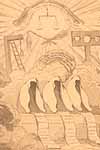 Paine Rebuked
Paine Rebuked
Even before the publication of the Age of Reason, Thomas Paine was hated and feared for his
political and religious radicalism by conservatives in England, where he had periodically lived
since 1787. Paine fled to France in December 1792 to avoid trial for treason. In this cartoon,
Paine sleeps on a straw pillow wrapped in an American flag, inscribed "Vive L' America." In
his pocket is a copy of Common Sense. On the headboard are his two "Guardian Angels":
Charles James Fox and Joseph Priestley. An imp drops a French Revolutionary song as he
flees through a window, draped in curtains decorated with the fleur-de-lis. Confronting Paine
are the spirits of three judges who will try him. The presiding judge declares that Paine will
die like a dog on the gallows.
Tom Paine's Nightly Pest.
Engraving by James Gillray. London: published by H.
Humphrey, 1792
Prints and Photographs Division, Library of Congress (182)
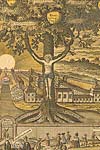 The Tree of Life
The Tree of Life
The evangelical spirit was embodied in men like John Hagerty (b. 1747), a Methodist preacher
who established himself as a Baltimore printer-publisher specializing in evangelical works.
Hagerty in 1791 published prints depicting a Tree of Life, a Tree of Virtues and a Tree of
Vices, motifs used in religious art for centuries. The Tree of Life brings forth, under the
redemptive rays of God as Father, Spirit and Word, twelve fruits of salvation for those seeking
entry into the New Jerusalem. A large crowd strolls by the narrow gate of salvation along the
Broad Way to the Devil and "babylon Mother of Harlots" beckon. The secure sinners are
stigmatized with labels indicating: "pride," "chambering & wantonness," "quack," "usury,"
and "extortion."
The Tree of Life
Hand-colored engraving. Baltimore: printed for John Hagerty, 1791
Maryland Historical Society Library, Baltimore, Maryland (183)
|

THE CAMP MEETING
|
In 1800 major revivals that eventually reached into almost every corner of the land began at
opposite ends of the country: the decorous Second Great Awakening in New England and the
exuberant Great Revival in Kentucky. The principal religious innovation produced by the
Kentucky revivals was the camp meeting. The revivals were organized by Presbyterian
ministers, who modeled them after the extended outdoor "communion seasons," used by the
Presbyterian Church in Scotland, which frequently produced emotional, demonstrative displays
of religious conviction. In Kentucky the pioneers loaded their families and provisions into
their wagons and drove to the Presbyterian meetings, where they pitched tents and settled in
for several days. When assembled in a field or at the edge of a forest for a prolonged
religious meeting, the participants transformed the site into a camp meeting. The religious
revivals that swept the Kentucky camp meetings were so intense and created such gusts of
emotion that their original sponsors, the Presbyterians, as well the Baptists, soon repudiated
them. The Methodists, however, adopted and eventually domesticated camp meetings and
introduced them into the eastern United States, where for decades they were one of the
evangelical signatures of the denomination.
|
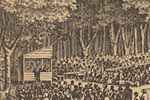 Outdoor Communion
Outdoor Communion
The Kentucky revivals originated with Presbyterians and emerged from marathon outdoor
"communion seasons," which were a feature of Presbyterian practice in Scotland.
Sacramental Scene in a Western Forest
Lithograph by P.S. Duval, ca. 1801, from Joseph
Smith, Old Redstone. Copyprint. Philadelphia: 1854.
General Collections, Library of Congress (184)
 Camp Meeting Plan
Camp Meeting Plan
This sketch, by Benjamin Latrobe, shows the layout of an 1809 Methodist camp meeting in
Fairfax County, Virginia. Note that the men's seats were separated from the women's and the
"negro tents" from the whites.' This is an example of the racial segregation that prompted
black Methodists to withdraw from the denomination a few years later and form their own
independent Methodist church. To accommodate the powerful, at times uncontrollable,
emotions generated at a camp meeting, Latrobe indicated that, at the right of the main camp,
the organizers had erected "a boarded enclosure filled with straw, into which the converted
were thrown that they might kick about without injuring themselves."
Plan of the Camp, August 8, 1809
Journal of Benjamin Latrobe,
August 23, 1806- August 8, 1809
Sketch by Benjamin Henry Latrobe
Latrobe Papers, Manuscript Department, Maryland Historical Society, Baltimore (185)
|
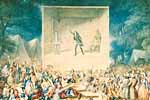 Religious Revival in America
Religious Revival in America
In 1839 J. Maze Burbank exhibited at the Royal Society in London this watercolor of "a camp
meeting, or religious revival in America, from a sketch taken on the spot." It is not known
where, when, or under whose auspices the revival painted by Burbank occurred.
Religious Camp Meeting.
Watercolor by J. Maze Burbank, c. 1839
Old Dartmouth Historical Society-New Bedford Whaling Museum,
New Bedford, Massachusetts.
Gift of William F. Havemeyer (187)
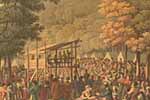
Methodist camp meeting, March 1, 1819
Engraving
Prints and Photographs Division, Library of Congress. (186)
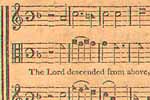
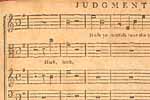 Revival Hymnals
Revival Hymnals
Both of these books contain hymns that would have been sung at nineteenth century revivals.
Samuel Wakefield, The Christian's Harp . . . suited to the various Metres
now in use among the different Religious Denominations . . . in the United States
Pittsburgh: Johnston and Stockton, 1837
The Easy Instructor; or, A New Method of Teaching Sacred Harmony.
William Little and William Smith.
Albany: Websters & Skinner and Daniel Steele, c. 1798
Music Division, Library of Congress (188-189)
|

THE EMERGENCE OF THE AFRICAN AMERICAN CHURCH
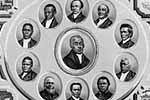 Bishops of the African Methodist Episcopal Church
Bishops of the African Methodist Episcopal Church
In the center is Richard Allen, founder of the African Methodist Episcopal Church,
surrounded by ten bishops of the church. At the upper left and right corners are pictures of
Wilberforce University and Payne Institute; other scenes in the life of the church are depicted,
including the sending of missionaries to Haiti in 1824.
Bishops of the A.M.E. Church.
Engraving by John H. W. Burley,
Washington, D. C., 1876.
Boston: J. H. Daniels, 1876
Prints and Photographs Division,
Library of Congress (190)
 Woman Preacher of the A.M.E. Church
Woman Preacher of the A.M.E. Church
The black churches were graced by eloquent female preachers from their earliest days,
although there was, as in the white churches, resistance in many quarters to the idea of women preaching the Gospel.
Mrs. Juliann Jane Tillman,
Preacher of the A.M.E. Church.
Engraving by P. S. Duval,
after
a painting by Alfred Hoffy, Philadelphia, 1844
Prints and Photographs Division,
Library of Congress (191)
|
Scholars disagree about the extent of the native African content of black Christianity as it
emerged in eighteenth-century America, but there is no dispute that the Christianity of the
black population was grounded in evangelicalism. The Second Great Awakening has been
called the "central and defining event in the development of Afro-Christianity." During these
revivals Baptists and Methodists converted large numbers of blacks. However, many were
disappointed at the treatment they received from their fellow believers and at the backsliding in
the commitment to abolish slavery that many white Baptists and Methodists had advocated
immediately after the American Revolution. When their discontent could not be contained,
forceful black leaders followed what was becoming an American habit--forming new
denominations. In 1787 Richard Allen (1760-1831) and his colleagues in Philadelphia broke
away from the Methodist Church and in 1815 founded the African Methodist Episcopal (A. M. E.) Church, which, along with independent black Baptist congregations, flourished as the
century progressed. By 1846, the A. M. E. Church, which began with 8 clergy and 5
churches, had grown to 176 clergy, 296 churches, and 17,375 members.
|
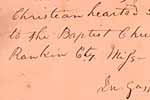
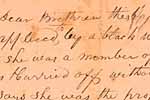 Christian Charity
Christian Charity
In the letter below, a Mississippi Baptist church informs a Virginia Baptist church that it has
been approached by a slave, Charity, who has been sold from Virginia to Mississippi, but
nevertheless wishes to let her old fellow church members in Virginia know that she is praying
for them and especially for "all her old Mistress family." Charity also wants it known that
"her most pious affections and prayers" are that her old mistress, Mary S. Garret (Garnett),
"become prepared to meet her in heaven."
Mt. Pisgah Baptist Church, Rankin City, Mississippi,
to Upper King and Queen Baptist Church, Newtown, Virginia [left page] -
[right page]
Manuscript letter, June 1837.
Virginia Baptist Historical Society (192)
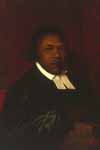 Absalom Jones
Absalom Jones
Born a slave in Delaware, Absalom Jones (1746-1818), was a founding member of the African
Episcopal Church of St. Thomas in Philadelphia, dedicated on July 17, 1794. A year later
Jones was ordained as the first black Episcopal priest in the United States.
Absalom Jones
Oil on canvas on board by Raphaelle Peale, 1810
Delaware Art Museum, Wilmington. Gift of the Absalom Jones School (193)
Congressional Assistance to Absalom Jones
In this receipt, Absalom Jones acknowledges receiving from Samuel Wetherill, a leader of the
Free Quakers of Philadelphia, a donation of $186, collected from members of the House and
Senate, to assist in promoting the mission of Jones's "St. Thomases African Church in
Philadelphia."
Receipt, signed by Absalom Jones, December 26, 1801
Manuscript Division, Library of Congress (193a)
 Religious Exuberance
Religious Exuberance
Emotional exuberance was characteristic of evangelical religion in both the white and black
communities in the first half of the nineteenth century.
Negro Methodists Holding a Meeting in a Philadelphia Alley.
Watercolor by John Lewis Krimmel
The Metropolitan Museum of Art, Rogers Fund, 1942 (194)
 Jerking Exercise
Jerking Exercise
Lorenzo Dow (1777-1834) was a spellbinding but eccentric traveling Methodist evangelist who
could still a turbulent camp meeting with "the sound of his voice or at the sight of his fragile
but awe-inspiring presence." Dow's audiences often exhibited unusual physical manifestations
under the influence of his impassioned preaching.
Lorenzo Dow and the Jerking Exercise.
Engraving by Lossing-Barrett, from
Samuel G. Goodrich, Recollections of a Lifetime.
Copyprint. New York: 1856
General Collections, Library of Congress (195)
 The Shakers
The Shakers
The Shakers, or the United Society of Believers in Christ's Second Coming, were founded by
"Mother Ann Lee, a stalwart in the "Shaking Quakers" who migrated to America from
England in 1774. American Shakers shared with the Quakers a devotion to simplicity in
conduct and demeanor and to spiritual equality. They "acquired their nickname from their
practice of whirling, trembling or shaking during religious services." The Shakers used
dancing as a worship practice. They often danced in concentric circles and sometimes in the
style shown here. Shaker emissaries from New York visited Kentucky in the early years of
the nineteenth century to assess the revivals under way there and made a modest number of
converts.
Shakers near Lebanon state of N York, their mode of worship.
Stipple and line engraving, drawn from life.
Prints and Photographs Division, Library of Congress (196)
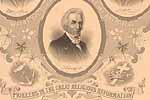 Nineteenth Century Religious Leaders
Nineteenth Century Religious Leaders
Two of these pioneers, Barton Stone and Alexander Campbell, were Presbyterian ministers
who, for different reasons, left the denomination and formed, in 1832, the Disciples of Christ.
While an active Presbyterian minister, Stone organized the powerful Cane Ridge revival, near
Lexington, Kentucky in the summer of 1801.
Pioneers in the Great Religious Reformation of the Nineteenth Century.
Steel engraving by J. C. Buttre,
after a drawing by J. D. C. McFarland, c. 1885
Prints and Photographs Division, Library of Congress (197)
|

THE MORMONS
|
Another distinctive religious group, the Church of Jesus Christ of Latter-day Saints or the
Mormons, arose in the 1820s during the "Golden Day of Democratic Evangelicalism." The
founder, Joseph Smith (1805-1844), and many of his earliest followers grew up in an area of
western New York called the "Burned Over District," because it had been "scorched" by so
many revivals. Smith had been "seared but not consumed" by the exuberant evangelicalism of
the era. However the Mormon Church cannot be considered as the product of revivalism or as
a splintering off from an existing Protestant denomination. It was sui generis, inspired by
what Smith described as revelations on a series of gold plates, which he translated and
published as the Book of Mormon in 1830. The new church conceived itself to be a
restoration of primitive Christianity, which other existing churches were considered to have
deserted. The Mormons subscribed to many orthodox Christian beliefs but professed
distinctive doctrines based on post-biblical revelation.
Persecuted from its inception, the Mormon Church moved from New York to Ohio to
Missouri to Illinois, where it put down strong roots at Nauvoo. In 1844 the Nauvoo
settlement was devastated by its neighbors, and Smith and his brother were murdered. This
attack prompted the Mormons, under the leadership of Brigham Young, to migrate to Utah,
where the first parties arrived in July 1847. The church today is a flourishing, worldwide
denomination.
|
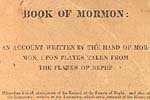 The Book of Mormon
The Book of Mormon
The Book of Mormon, the fundamental testament of the Church of Jesus Christ of Latter-day
Saints, was published by Joseph Smith in 1830. According to a standard reference work,
Smith translated it from "golden plates engraved in a language referred to as reformed
Egyptian.' The plates, which were seen and handled by 11 witnesses, deal chiefly with the
inhabitants of the American continents spanning the period 600 B.C. to A.D. 421. The plates
relate the sacred history of Israelites who, led by a divinely directed righteous man named
Lehi, emigrated from Jerusalem to the New World, where Christ appeared and gave them his
teachings. The record of their experiences, kept by various prophets, was compiled and
abridged by the 5th century prophet Mormon. . . ."
Book of Mormon:
An Account written by the Hand of Mormon,
upon plates taken from the Plates of Nephi
Joseph Smith, Junior. Palmyra, N.Y.: E.B. Grandin, 1830
Rare Book and Special Collections Division,
Library of Congress (198)
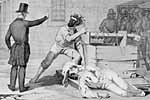 The Murder of Joseph and Hiram Smith
The Murder of Joseph and Hiram Smith
The murder of Joseph Smith and his brother, Hiram, by a mob in Carthage, Illinois,
prompted the Mormons, under the leadership of Brigham Young, to migrate in 1846-1847 to
Utah, where they found a permanent home. Although accounts differ, Joseph Smith was apparently
shot to death by a mob, one of whose members approached him with the intention, which was
thwarted, of beheading him.
Martyrdom of Joseph and Hiram Smith
in Carthage Jail, June 27, 1844
Tinted lithograph by Nagel & Weingaertner,
after C. G. Crehen. New York: 1851
Prints and Photographs Division,
Library of Congress (199)
|
![Route of the Mormon Pioneers from Nauvoo to Great Salt Lake, Feb'y 1846-July 1847. [right]](vc6590th.jpg)
![Route of the Mormon Pioneers from Nauvoo to Great Salt Lake, Feb'y 1846-July 1847. [left]](vc6589th.jpg) Migration to Utah
Migration to Utah
This map shows the route of the migration of the Mormons from Illinois to Utah.
Route of the Mormon Pioneers from Nauvoo to Great Salt Lake, Feb'y 1846-July 1847 [left] -
[right]
Map, copyright by Millroy and Bates, 1899. Facsimile
Geography and Map Division, Library of Congress (200)
|

BENEVOLENT SOCIETIES
 The Distribution of Religious Literature
The Distribution of Religious Literature
The American Tract Society, founded in 1825, was one of the most
influential of the scores of benevolent societies that flourished
in the United States in the first decades of the nineteenth century.
The Tract Society, through the efforts of thousands of families
like the one shown here, flooded the nation with evangelical pamphlets,
aimed at converting their recipients and eradicating social vices
like alcoholism and gambling that impeded conversion. In the first
decade of its existence the American Tract Society is estimated
to have distributed 35 million evangelical books and tracts.
Family handing out tracts
Woodcut by Anderson from
he American Tract Magazine, August 1825.
American Tract Society, Garland, Texas (205)
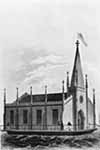 Mission to Sailors
Mission to Sailors
Missionary societies in nineteenth-century America left no stone unturned or no place
unattended to convert their fellow Americans. This church was built by the Young Men's
Church Missionary Society of New York to minister to visiting seamen. A floating church,
built to a similar design, was moored on the Philadelphia waterfront.
The Floating Church of Our Saviour...For Seamen (Built New York Feb.15th, 1844. . . )
Steel engraving. Copyprint
Prints and Photographs Division, Library of Congress (206)
|
Benevolent societies were a new and conspicuous feature of the American landscape during the
first half of the nineteenth century. Originally devoted to the salvation of souls, although
eventually to the eradication of every kind of social ill, benevolent societies were the direct
result of the extraordinary energies generated by the evangelical movement--specifically, by
the "activism" resulting from conversion. "The evidence of God's grace," the Presbyterian
evangelist, Charles G. Finney insisted, "was a person's benevolence toward others." The
evangelical establishment used this powerful network of voluntary, ecumenical benevolent
societies to Christianize the nation.
The earliest and most important of these organizations focused their efforts on the
conversion of sinners to the new birth or to the creation of conditions (such as sobriety sought
by temperance societies) in which conversions could occur. The six largest societies in
1826-1827 were all directly concerned with conversion: the American Education Society, the
American Board of Foreign Missions, the American Bible Society, the American
Sunday-School Union, the American Tract Society, and the American Home Missionary Society.
|
![Evangelical tracts, American Tract Society. [Everlasting punishment]](vc6433th.jpg)
![Evangelical tracts, American Tract Society. [Are you saved.]](vc6432th.jpg)
Evangelical tracts,
American Tract Society
[top left] --
[top right]
![Evangelical tracts, American Tract Society. [To the parents of Sabbath school children]](vc6435th.jpg)
![Evangelical tracts, American Tract Society. [Misery of the lost]](vc6434th.jpg)
[bottom left] --
[bottom right]
YA Pamphlet Collection
Rare Book and Special Collections Division, Library of Congress. (201-4)
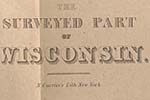 Missions to the Old Northwest
Missions to the Old Northwest
The evangelical community was extremely anxious about the supposedly deleterious moral
impact of westward expansion. Consequently, strenuous efforts were made to send ministers
to serve the mobile western populations. In this issue of the Home Missionary, the journal of
the American Home Missionary Society, a map of the surveyed parts of Wisconsin was
published with a letter from a "correspondent at Green Bay," who asserted, like the man from
Macedonia, "that an immediate supply [of ministers] is demanded." The executive Committee
of the Society decided "to make immediate and energetic efforts to supply Wisconsin with the
preaching of the Gospel.
The surveyed part of Wisconsin.
Map from The Home Missionary, volume XII, November
1839
New York: N. Currier, c. 1839
General Collections, Library of Congress (208)
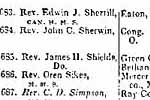 Missionaries' Reports
Missionaries' Reports
This table, compiled from data from the missionaries of the American Home Mission Society,
reports on revivals in progress and other missionary activities under their auspices in 1841-1842.
Missionary Table from The Seventeenth Report of the American Home Missionary Society
New York: William Osborn, 1842
American Home Missionary Society Papers, Amistad Research Center,
Tulane University, New Orleans (207)
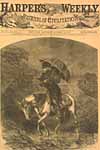 Circuit Preaching
Circuit Preaching
The Methodist Circuit rider, ministering to the most remote, inhospitable parts of the nation,
was one of the most familiar symbols of the "evangelical empire" in the United States. The
saddle bags, seen here, belonged to the Reverend Samuel E. Alford, who rode circuits in
northwestern Virginia, eastern West Virginia, and western Maryland.
The Circuit Preacher
Engraving of a drawing by A. R. Waud,
from Harper's Weekly,
October 12, 1867. Copyprint
Prints and Photographs Division, Library of Congress (209)
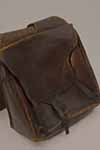
Saddle bags
Leather, used c. 1872-1889
Lovely Lane Museum of United Methodist Historical Society, Baltimore (210)
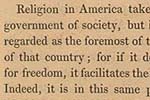 Religion Indispensable to Republican Government
Religion Indispensable to Republican Government
Tocqueville's impression of American attitudes toward the relation of government and religion
was formed on his tour of the United States in the early 1830s during the high tide of
evangelicalism:
I do not know whether all Americans have a sincere faith in their religion; for
who can read the human heart? but I am certain that they hold it to be
indispensable to the maintenance of republican institutions. This opinion is not
peculiar to a class of citizens or to a party, but it belongs to the whole nation
and to every rank of society.
Democracy in America
Alexis de Tocqueville, Translated by Henry Reeve
London: Saunders and Otley, 1835
Rare Book and Special Collections Division, Library of Congress (211)
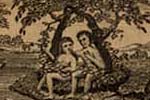 A Thousand Years of Happiness
A Thousand Years of Happiness
Time lines that traced sacred history from Adam and Eve to contemporary times were a
popular form of religious art in earlier periods of American history. The one seen here,
prepared by the well-known engraver, Amos Doolittle, states that in 1800 Americans entered a
"fourth period" in which Satan would be bound for "1000 years" and the church would be in
a "happy state."
The Epitome of Ecclesiastical History
Engraving by Amos Doolittle. New Haven: 1806
Rare Book and Special Collections Division, Library of Congress (212)
|
 HOME -
EXHIBITION OVERVIEW
HOME -
EXHIBITION OVERVIEW
SECTIONS:
I. America as Refuge -
II. 18th Century America
III. American Revolution -
IV. Congress of the Confederation -
V. State Governments
VI. Federal Government -
VII. New Republic

|

 The Atheist's Bible
The Atheist's Bible Paine Rebuked
Paine Rebuked The Tree of Life
The Tree of Life Outdoor Communion
Outdoor Communion Camp Meeting Plan
Camp Meeting Plan Religious Revival in America
Religious Revival in America

 Revival Hymnals
Revival Hymnals Bishops of the African Methodist Episcopal Church
Bishops of the African Methodist Episcopal Church Woman Preacher of the A.M.E. Church
Woman Preacher of the A.M.E. Church
 Christian Charity
Christian Charity Absalom Jones
Absalom Jones Religious Exuberance
Religious Exuberance Jerking Exercise
Jerking Exercise The Shakers
The Shakers Nineteenth Century Religious Leaders
Nineteenth Century Religious Leaders
 The Book of Mormon
The Book of Mormon The Murder of Joseph and Hiram Smith
The Murder of Joseph and Hiram Smith![Route of the Mormon Pioneers from Nauvoo to Great Salt Lake, Feb'y 1846-July 1847. [right]](vc6590th.jpg)
![Route of the Mormon Pioneers from Nauvoo to Great Salt Lake, Feb'y 1846-July 1847. [left]](vc6589th.jpg) Migration to Utah
Migration to Utah The Distribution of Religious Literature
The Distribution of Religious Literature Mission to Sailors
Mission to Sailors![Evangelical tracts, American Tract Society. [Everlasting punishment]](vc6433th.jpg)
![Evangelical tracts, American Tract Society. [Are you saved.]](vc6432th.jpg)
![Evangelical tracts, American Tract Society. [To the parents of Sabbath school children]](vc6435th.jpg)
![Evangelical tracts, American Tract Society. [Misery of the lost]](vc6434th.jpg)
 Missions to the Old Northwest
Missions to the Old Northwest Missionaries' Reports
Missionaries' Reports Circuit Preaching
Circuit Preaching
 Religion Indispensable to Republican Government
Religion Indispensable to Republican Government A Thousand Years of Happiness
A Thousand Years of Happiness